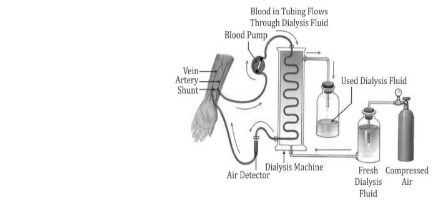To describe the scientific term, ‘dialysis’ is the procedure of separating molecules in specific solutions using a semipermeable membrane termed a dialysis tube. Dissolved ions and molecules are separated from solid solutions. There is a variation in the diffusion rate of some molecules in the solution, which causes the separation of molecules.
Dialysis
Dialysis is a chemical method that uses distinguishing the sizes of molecules present in a solution to modify the size as well as the matrix of molecules in a certain sample. Because only tiny molecules may move through the dialysis tube or membrane, equilibrium is achieved between the solution and the celluloid during the dialysis process. In the process of removing salt, the dialysis chemical separation is also employed.
As the fluid travels from a high to a low water content, osmosis aids in the smooth operation of dialysis by making it easier to pass through a dialysis tube or semipermeable membrane.
Ultrafiltration also aids dialysis by removing superfluous fluid and tiny molecules from the sample solution, making the dialysis operation incredibly simple and quick to complete.
Dialysis Definition
Dialysis is a renal failure treatment that filters your blood to remove undesirable toxins, waste products, and excess fluids. When your kidneys are damaged (fail), your body could have trouble cleaning the blood and maintaining a chemically balanced system. Dialysis can help you live longer by replacing some kidney function and, in combination with medication and adequate care, it can help you live longer.
History of Dialysis
In the year 1868, a Scottish scientist named Thomas Graham created and introduced the chemical method of dialysis.
In an aqueous solution, Graham employed this approach to separate small molecules from large molecules. Colloids is the name he gave to diffusible compounds like crystalloids and those which would become caught in the dialysis tube or membrane. Graham’s Law is the name given to this separation process in chemistry.
Mechanism of Dialysis
- Cellophane tubes having a semi – permeable lining line the prosthetic kidney.
- Such tubes are suspended in a solution of dialysis which are filled with a tank.
- Water and glucose are present in this fluid at amounts similar to those seen in blood.
- Blood is drawn from the patient’s radial artery and are cooled to 0°C.
- Heparin, an anticoagulant, is then added to blood.
- The blood is then transported through coiled cellophane tubes that are semi-permeable.
- Small molecules including urea, creatinine, and uric acid can flow through the tubes.
- In the surrounding solution, metabolic wastes are also filtered away.
- Proteins and other macromolecules, on the other hand, remain in the blood.
- Anti Heparin is included in purified blood, which is then warmed to the temperature of the body.
Types of Dialysis
Peritoneal Dialysis
Peritoneal dialysis uses the peritoneum like a natural semipermeable barrier to remove wastes and water from the blood within the body. The peritoneal membrane transports wastes and surplus water from the circulation into an abdominal cavity dialysate dialysis solution. Peritoneal dialysis involves injecting a sterile dialysate solution rich in minerals & glucose into the peritoneal cavity, the abdominal body cavity which surrounds the colon, through a tube. Peritoneal membrane is a semi – permeable membrane that separates the abdominal cavity from the rest of the body.
Haemodialysis
The haemodialysis procedure involves the patient’s blood being passed through a dialysis machine, in which it is filtered and back to them. The filters, such as the kidneys, filter the blood to remove waste. The filtered blood is then returned to the patient through a second catheter. The system works in the same way as an artificial kidney. Haemodialysis can be done at home or at a hospital’s dedicated dialysis unit.
Conclusion
Dialysis is a medical process that eliminates solutes, excess water, and toxins from blood in persons whose kidneys can’t do it on their own. Renal replacement treatment (RRT) is another name for it. The principles of fluid ultrafiltration and solute diffusion over a semipermeable membrane are used in dialysis. In 1943, the first dialysis procedure was successfully completed.
There are two types of dialysis which are; haemodialysis and Peritoneal dialysis.
 Profile
Profile Settings
Settings Refer your friends
Refer your friends Sign out
Sign out







